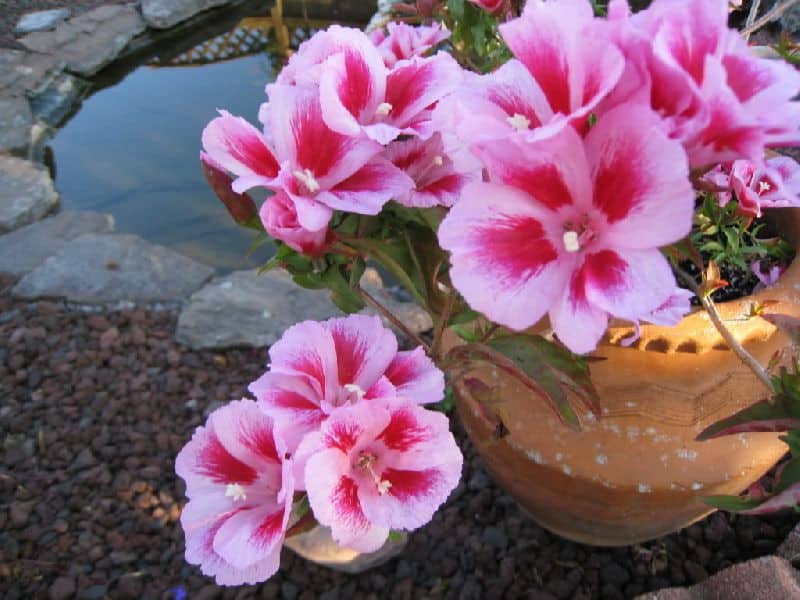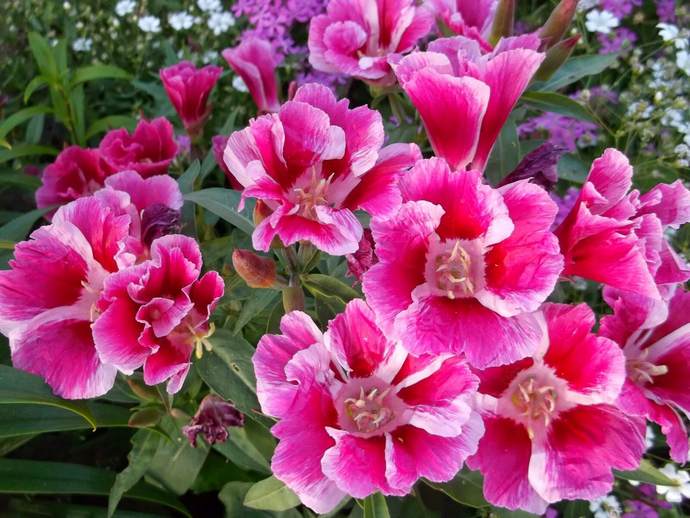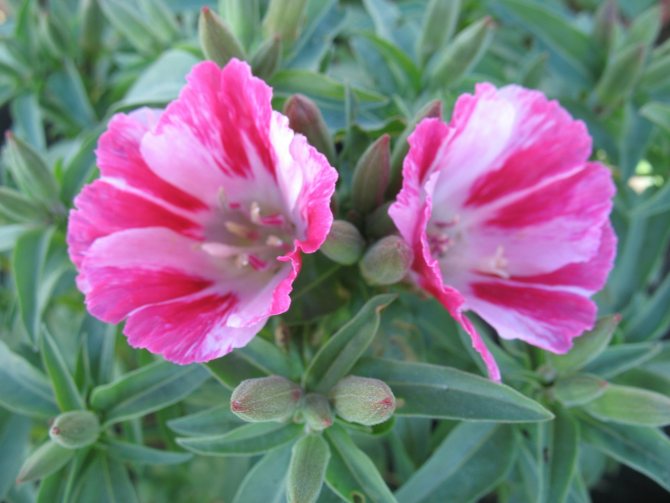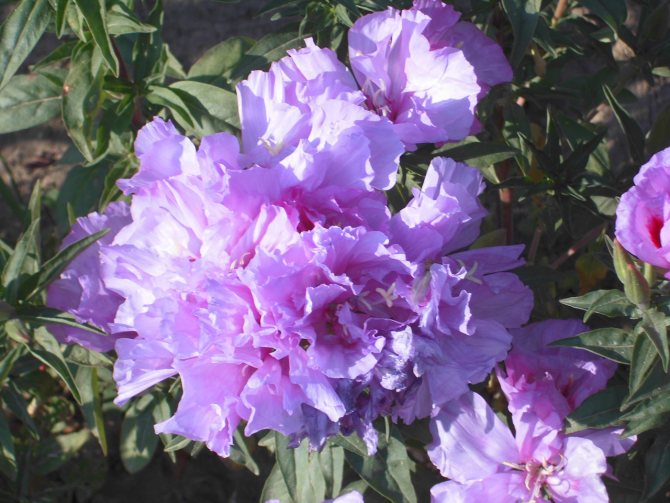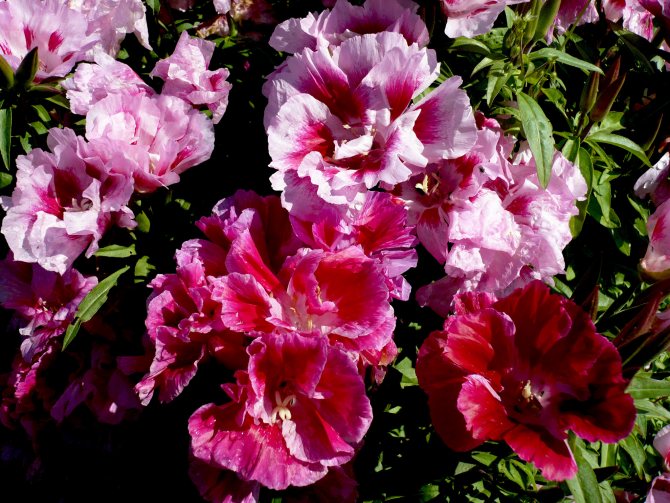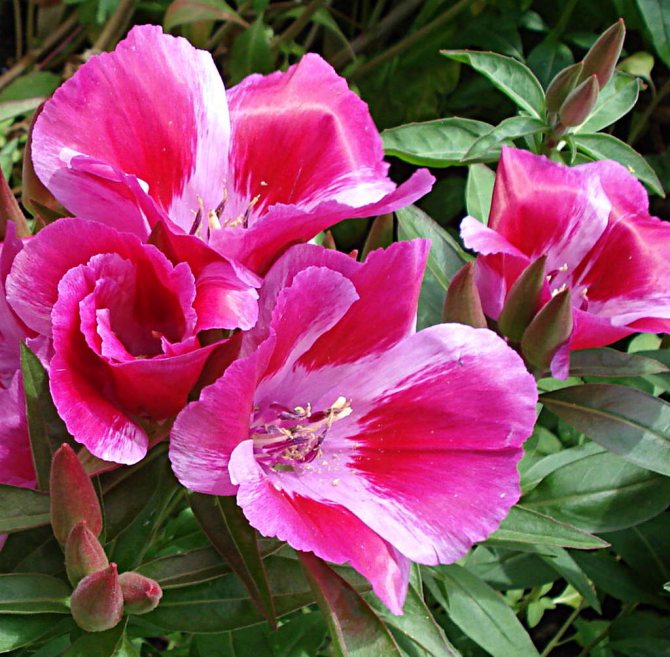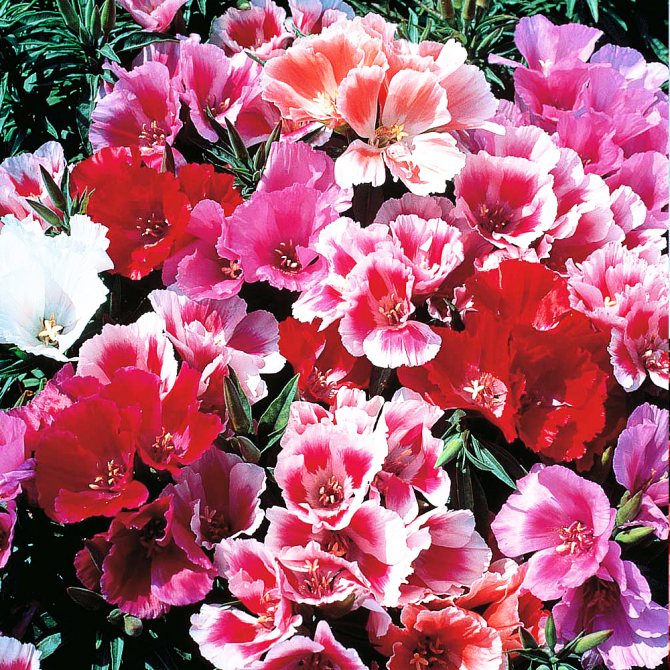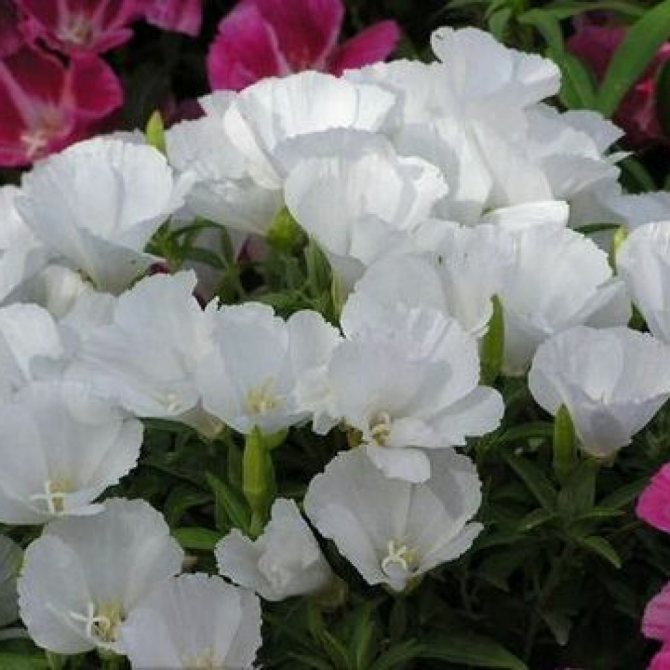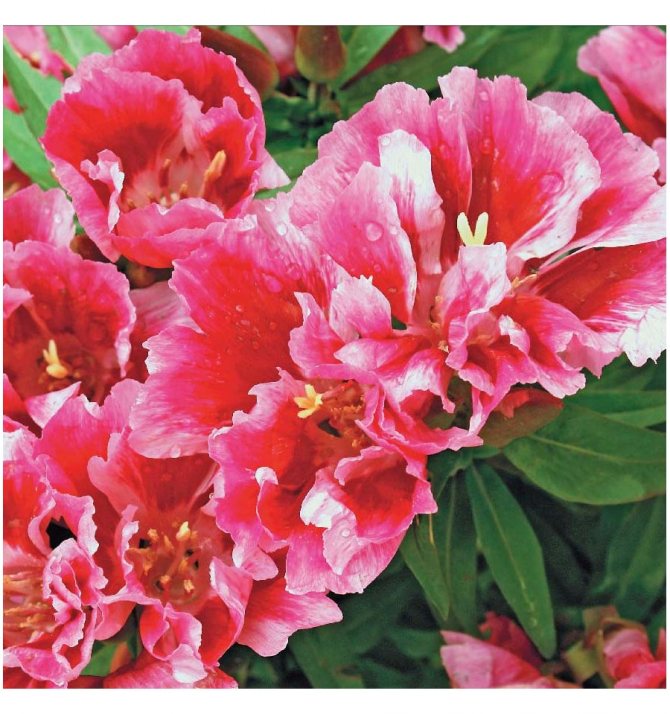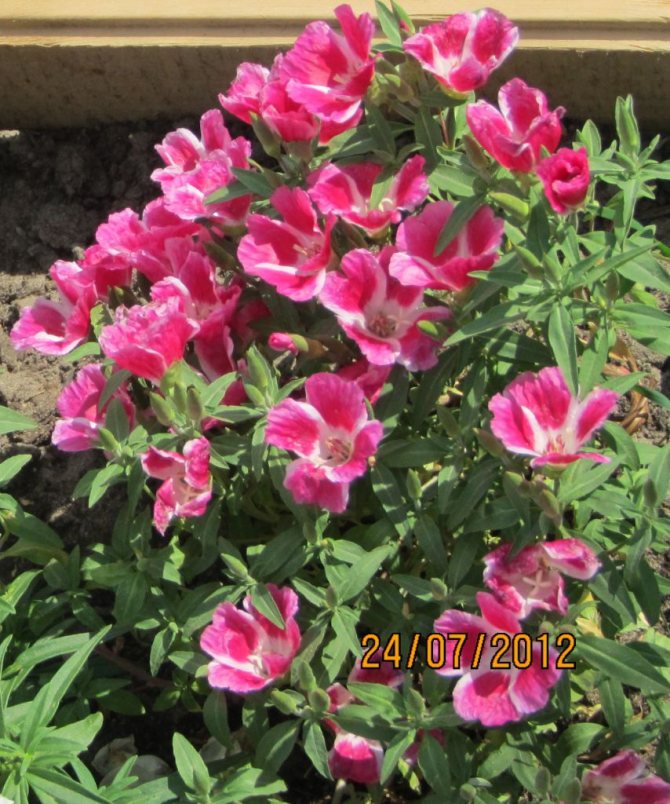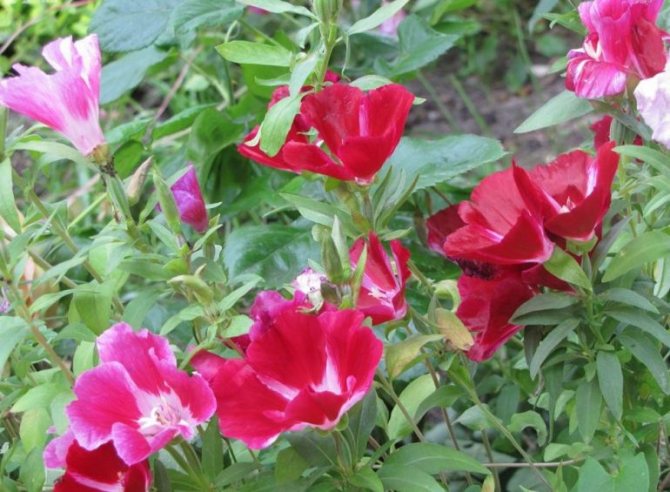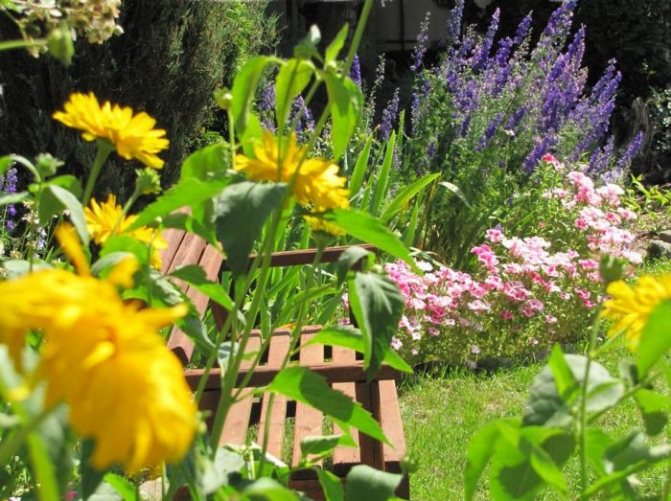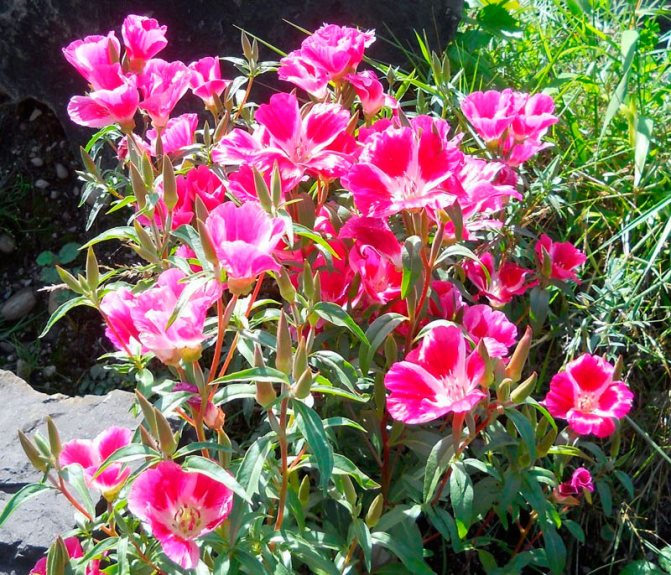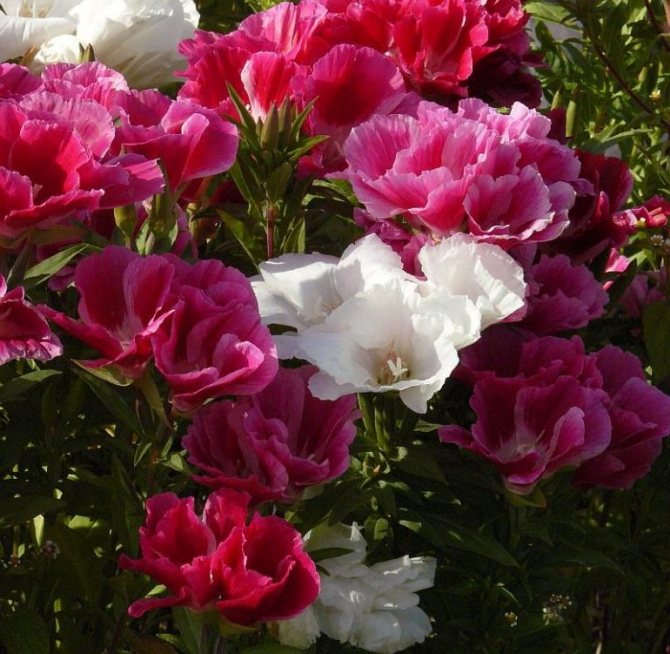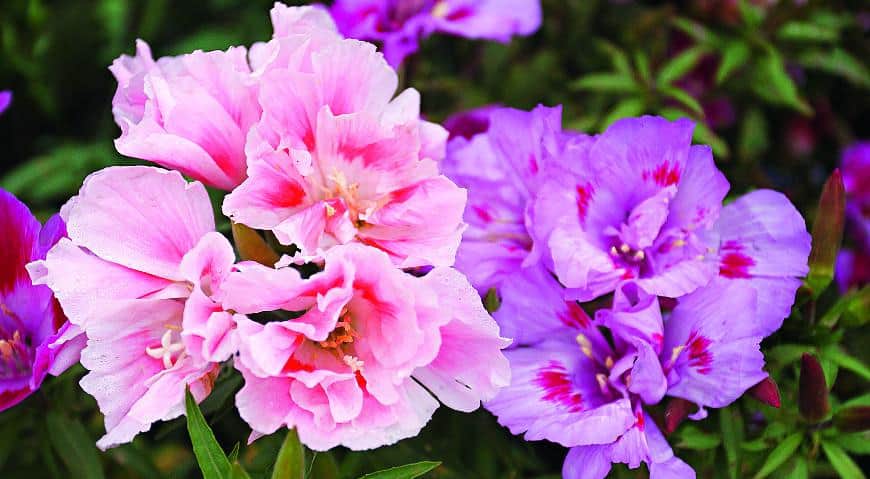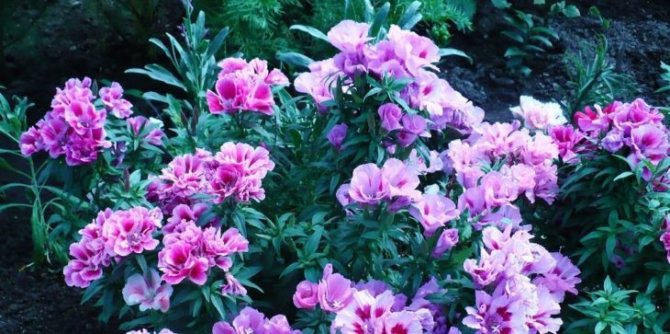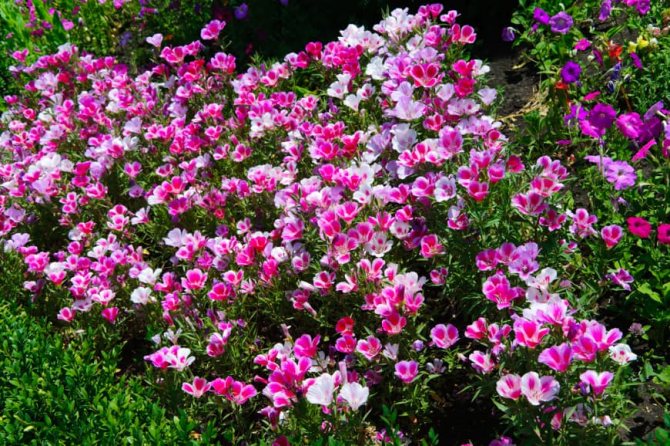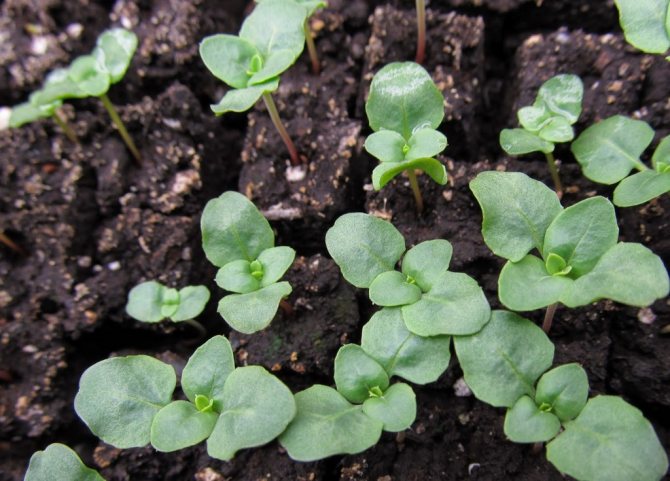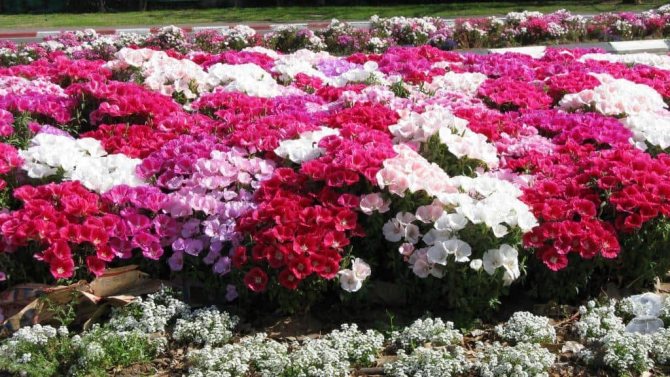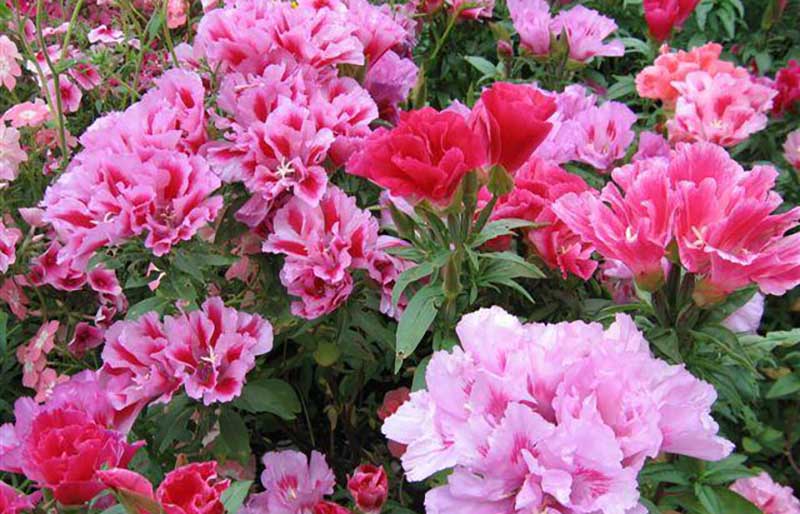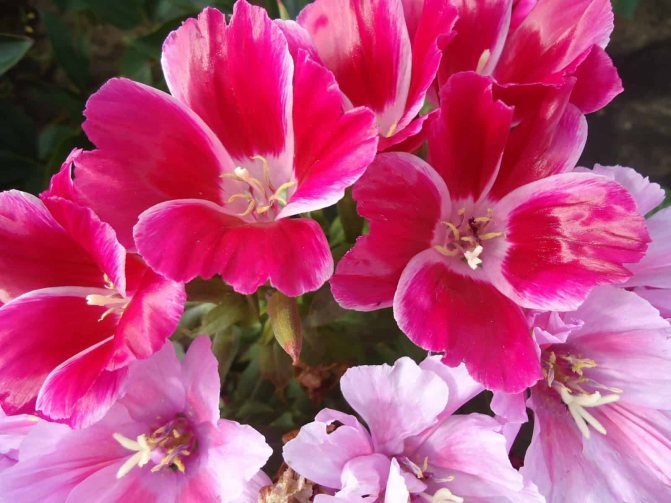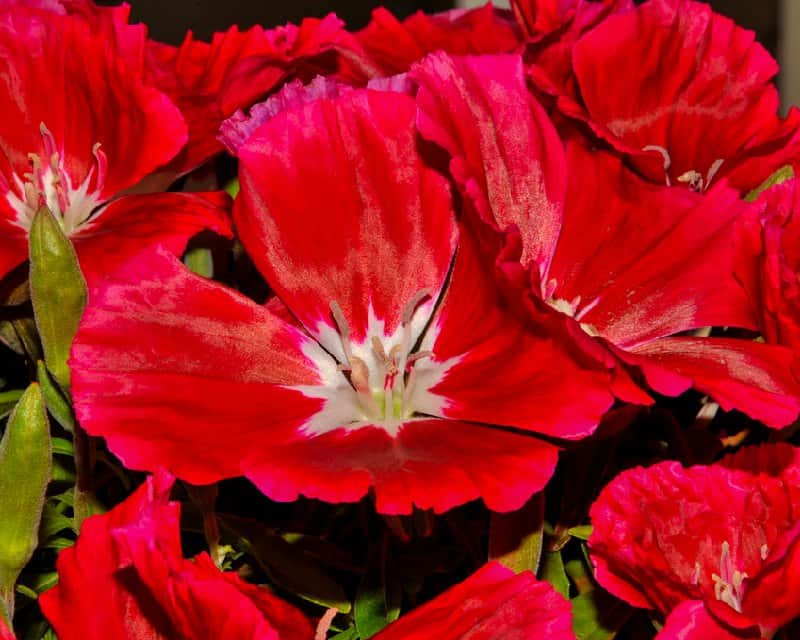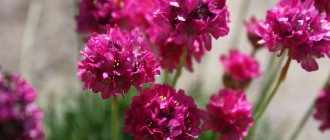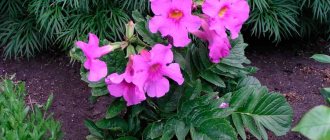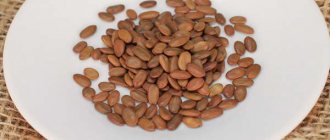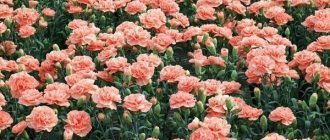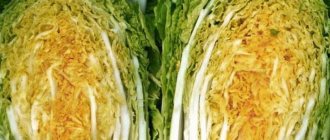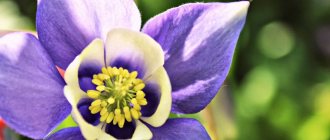Godetia is a flower of passion - she, like a boiling volcano, is reborn every year from a small seed to again delight the human eye. Godetia is a relative of clarkia, but they are different plants, although both belong to the fireweed family. A favorite of many flower growers, godetia attracts with her bright outfit, amazes and surprises, forever remaining in my memory. She is graceful like a true lady and attracted gardeners not only for the bright color of large flowers, but also for a long flowering period.
The progenitors of modern godetia grow on the plains of North and South America, they do not look very presentable, standing out only with the petals of flowers similar to satin silk. The first European to study and classify godetia was the Swiss botanist Godet, whose name immortalized this beautiful flower.
The delicate plant is used for flower beds, mixborders, rabatki, balcony boxes, outdoor vases. Godetia feels great both in flower beds and on flower beds, and under indoor conditions. Miniature varieties of godetia look unusually attractive in flower boxes on verandas and as a living border framing a flower garden or path.
Godetia is an annual cold-resistant plant of the Fireweed family with a straight, branched, heavily pubescent stem, linear-lanceolate leaves. Godetia bushes are spreading or narrow pyramidal. They are abundantly covered with flowers that look like azalea flowers of white-pinkish-red shades, which can be double or simple. Godetia flowers are spectacular large bell-shaped buds, collected in racemose inflorescences with a diameter of 4 to 10 cm.
Origin
Godetia is a beautiful annual plant of the fireweed family. The flower got its name from the name of the botanist Godet, who studied and classified the plant. The godetia is believed to have originated in California. After distribution, it decorates the gardens and parks of European countries, North and South America. Identified and classified about 20 flower species.

Homeland of the plant
Description
Almost all species are bushy and resemble an elongated pyramid in shape. Smooth or branched stems up to 60 cm long sometimes spread along the ground. The arrangement of lanceolate leaves on the stem is alternate. The flowers are bell-shaped or cupped in shape. Opened in any weather, the buds exude a pleasant, vanilla aroma.
Godetia flowers can be:
- Simple - the most common type
- Terry
- Monochrome or variegated
Godecy bloom lasts from July to September. With good care and warm weather, it stretches until October. Flowering ends with the appearance of seed bolls. A month after the appearance, they will fully ripen, which can be replaced by a dark color. The seeds can now be collected. They are dried a little and stored until next year. The collected godetia seeds do not lose their germination for 3-4 years.


Large-flowered
Types of godetia
- Large-flowered A bush 25-40 cm high is covered with bright pink, crimson, scarlet, burgundy flowers with pubescence are located at the top of young shoots. Their size reaches 10 cm.
- Pleasant The tall variety was bred back in 1814. Grows up to 60 cm in height.
- Terry It is a small bushes covered with delicate flowers. The size of the buds with double petals is 6-7 cm. It is distinguished by abundant color and endurance.
Godetia in landscape design
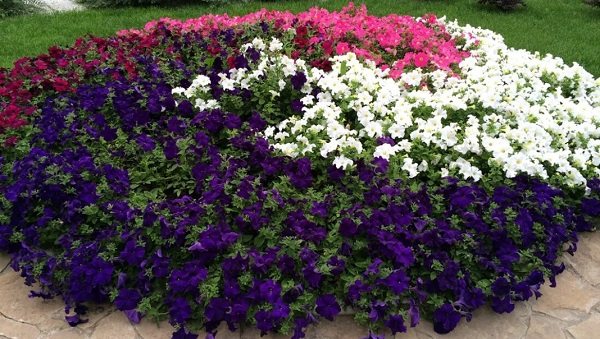

Luxurious branches from distant lands look so impressive that they compete with other recognized "queens of beauty" from gardens and flower beds. Large buds and brushes of various shades of red, pink, cream, salmon, white, lilac petals, two-tone specimens with a border and double petals look luxurious in single and group plantings. Godetia is suitable for decorating flower beds, borders, creating bright islands against the backdrop of a lawn. "California beauty" gives the site a solemn, elegant look.
Many gardeners ask if the combination with other plants is permissible? Landscape designers boldly advise complementing many compositions with such a flower as godetia. Photos of interesting compositions show how you can emphasize the sophistication of a plant. Nasturtium and marigolds are excellent combinations with the "Californian beauty".
For decorating a summer cottage and a garden, you can choose a luxurious flower with large buds and bright colors. "California beauty", as godetia is often called, has taken root well in regions with a temperate climate: the plant tolerates temperature fluctuations well, blooms for a long time, and is combined with other ornamental species. The best option is to grow seedlings for the strength of adult godets when grown outdoors.
From the video you can find out more useful information about the nuances of caring for godetia outdoors:
Varietal variety
The breeders have bred varieties of godetia, presented in the photo of flowers, many shapes, flowers and bushiness, which allows you to form graceful flower beds and border plantings of fascinating aesthetic appeal.
Among the most attractive varieties, it is worth noting:
- A diamond with red terry inflorescences dotted with white spots.
- The monarch is distinguished by early and lush flowering, as well as short stature. A dwarf variety up to 20 cm high is often used to decorate balconies and in pot culture. A compact bush withstands cold weather.
- A bride with snow-white buds in the shape of an azalea.
- Rembrandt has double, gorgeous pink flowers with a carmine mark in the center.
- The meteor is distinguished by its early flowering. Its red buds are slightly fleecy.
- Orange Rum has a branchy bush up to 45 cm high.It is covered with orange-red buds 5 cm in diameter during the flowering period.
- Sybil Sherwood is a compact and hardy shrub. Semi-double flowers are painted in salmon tone.
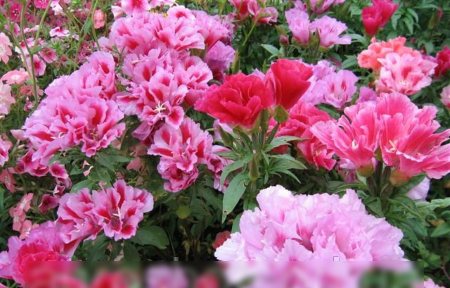

Monarch
Popular with Horta and hybrids with photos
Biologists have described a little more than 20 species of godetia, but in modern garden culture, numerous hybrids have been created on their basis, surpassing natural forms in the abundance of forms and colors - these are azalea and dwarf varieties, terry flowering and having spectacular bush and border varieties and others. Let's dwell on the most popular ones.
Godetia grandiflorum
A widespread variety on the European continent with erect or lodging fragile shoots, prone to lodging at high altitudes and woody by the end of the season. Clusters of leafy inflorescences are formed at the ends of the branches. Active budding lasts from mid-summer to late September. On the basis of this species, many cultivars and hybrids have been created, both of a medium layer and a squat dwarf form. The most famous of them:
- Weisser Schwann. It has a short, but spreading shape, perfect for decorating lawns and borders. Usually they do not stretch more than 30 cm. Shoots change their color from brownish brown at the base to green at the tops.Leaves are compact, broadly lanceolate, entire. It blooms with snow-white inflorescences with a satin tint up to 6 cm in diameter.
- Orange Room. The medium-sized variety is not higher than half a meter. Green stems have a reddish tint. Narrow-lanceolate leaf plates. Inflorescences about 6 cm, broadly bell-shaped, blooming in an orange-red palette.
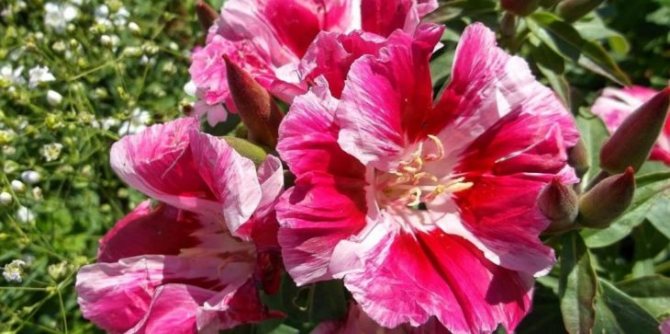

Dear godetia
A tall variety with smooth and very fragile erect, gradually lignified shoots and pointed leaf blades. It blooms with bell-shaped or cupped inflorescences of medium size. The traditional color scheme pleases with delicate shades of pink or lilac-lilac. The petals are expanding, spatulate. Flowering ends in September. The best varieties:
- Kirshkenigin. It blooms with buds of a pale pink tone with a transition to scarlet red.
- Crystal snowflake. A very tall variety with snow-white inflorescences, the stems of which reach 75 cm.


Terry godetia
This variety does not exist in nature; this conditional group includes hybrid varieties, characterized by large and dense double inflorescences. Some semi-double forms are also ranked here. It is especially worth highlighting the azalea group of terry varieties and its following favorites.
- Sybil Sherwood. A low-growing variety with attractively colored shoots - they have an interesting pink tint at the top. Flowers of medium diameter, two-colored, changing from deep pink to salmon tint to the edge of the petal.
- Rembrandt. The bushes of this variety have a low spherical shape, which looks very nice in the borders. Terry buds are painted in pink and fawn shades with spectacular carmine red bright spots. The petals are pronounced jagged along the edge.
- Diamond. This time, the spots, on the contrary, are white, and the main tone of the petals is bright red.
- Bride. Very delicate color with a subtle pink tinge on white buds.


Tall varieties of godetia are great for cutting. The viability of cut peduncles in water lasts up to 3 weeks.
Godetia care
Godetia is not demanding to care for, for which it is popular with flower growers.
For planting godetia, a sunny, loamy area saturated with humus is taken away. Dry and clayey soils are not suitable for the flower. Soils with neutral acidity are recommended. Alkaline soils are diluted with peat or urea.
In shaded areas of penumbra willows, the intensity of flowering decreases and the buds grow small. The site for godetia is fertilized with the introduction of compost, wood ash and nitrophoska in a ratio of 5 kg / 300 g / 2 tbsp. and dig up. You can limit yourself to adding only charcoal in a bucket per 1 square meter.
The flower does not like drought and stagnant moisture. It is better to use a drip irrigation system to organize proper watering.
It is recommended to spray the plant periodically to maintain the delicate leaves. The procedure is carried out after sunset to avoid burns. Spraying is especially necessary for pot and balcony plants.
Godetia bushes are distinguished by abundant flowering, the duration of flowering of one bud is only 3 days. The process can be controlled by plucking the excess ovary to form new buds. With the onset of drought or prolonged rains, flowering becomes less active.


Rembrandt
Growing recommendations
- For active growth of godetia, it is recommended to mix white clay into the soil when planting.
- Abundant watering is necessary only on dry days. The rest of the time, excess moisture will lead to plant diseases.
- The flower loves loose soil and the absence of weeds.
- Top dressing is carried out 2-3 times a month throughout the season with organic matter and mineral fertilizers containing a low percentage of nitrogen. "Agricola", "Ideal", nitrophoska solution will do.
- The absence of drying out and the removal of faded buds helps to extend the flowering period.
- For tall species, it is necessary to organize supports from pegs.
Growing from seeds
One of the features of the plant is its relatively high frost resistance. Even small sprouts can withstand frosts down to -2 degrees, and a drop in air temperature down to -5. The plant is sown in a flower bed, and the seedlings are covered with foil to provide protection. Sowing is carried out in the middle of spring. If your area has a mild climate, sowing before winter is allowed.
In regions where there is no harsh winter, godetia in seeds is sown in November. Before placing the seeds in the ground, they are preliminarily disinfected and dried in the sun, in a warm place. Then all crops are covered with earth, mulch. For additional frost protection, black foil or protective materials can be used.
The traditional sowing of godetia from seed is carried out in May. The soil is pre-dug up and loosened, and then moistened. The seed is immersed to a shallow depth - no more than 1 cm. To avoid picking, the distance between the bushes should be 25 cm. Dense plantings must be thinned out.
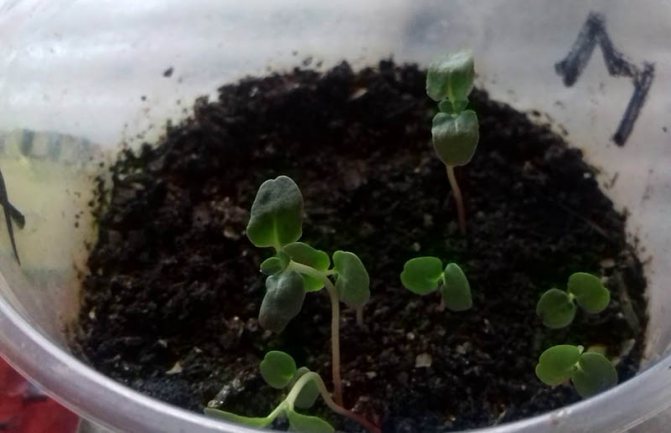

Growing godetia from seeds
Careless picking of godetia, improper planting can lead to the death of seedlings. Seedless cultivation is much simpler than seedling. But growing from seeds has its drawbacks. The growing season takes several months, sometimes up to 90 days. You understand, a decent period for an annual. So, despite all the difficulties and risks, for a godetia plant, planting seedlings looks much preferable.
Propagation of godetia by seeds
For propagation of godetia, seeds are used, which are previously kept in a warm, pale pink solution of potassium permanganate. The procedure helps to increase resistance to disease.
Seeds are sown directly into open ground or seedlings are grown. For the convenience of planting, seeds are mixed with fine sand or loose substrate. The seeding depth is 0.5-1 cm.
It is recommended to carry out autumn sowing and sprinkle the seeds with a small layer of earth. The time is chosen in late autumn, so that the seeds are saturated with moisture, but do not have time to germinate. Autumn planting gives abundant and early flowering.
In spring sowing, it is better to cover the flower bed with foil. Seedlings can be expected in 7-10 days.
Seedlings start growing in mid-March. Seeds are placed in containers with a light substrate and the soil is regularly moistened. Seedlings will appear by the end of 3 weeks. Places delicate seedlings in a lighted place without drafts. After the appearance of 2 full-fledged leaves, dive into separate pots. Two weeks later, the seedlings are fed with the Ideal fertilizer. Plants should be ventilated daily, avoiding exposure to cold air.


Meteor
Before transplanting to an open bed, the seedlings are hardened for 2 weeks. The site is pre-heated under the film. Godetia is resistant to light frosts, so planting on a flower bed can be carried out with the onset of May, when there will be cloudy weather and high humidity. Plants are ready for transplanting when they have reached 6 cm in height.
On the site, plants are planted at an interval of at least 20 cm so that during the flowering period the bushes do not shade each other, and there is no stagnation of moisture. Tall varieties are located farther from one another. Godetia seedlings are fed for the first time every 2 weeks. When transplanting, the earthen lump must not be disturbed, because the flower is sensitive to transplants and will hurt.
Landing in open ground


Spring planting of seedlings
Seedlings in open soil must be planted in the last days of May or the first in June, while the height of the plants should be from 5 to 7 centimeters. Planting should be done by taking the godetia along with a clod of earth, while trying to injure the root system as little as possible.It is recommended to disembark on a cloudy day, early in the morning (before the sun rises) or in the evening (after sunset). Do not forget that the distance between the specimens should be from 20 to 25 centimeters. Remember that the taller the variety, the longer the distance between the bushes should be.
Landing before winter
Before winter, seedlings can only be planted in areas with mild warm winters. It should be borne in mind that such landings are currently experimental in nature. Experienced gardeners try to sow seeds directly into open soil, since in this case it will be possible to avoid losses during a pick or planting in open soil. It is believed that plants grown from seeds sown in late autumn are more resistant to diseases and adverse weather conditions.
Damage by diseases and pests
Godetia can be amazed:
- Root rot from excess moisture. Infected bushes are removed and burned. The rest of the plants are treated with a special agent.
- Powdery mildew, to combat which damaged leaves are removed, and the plant is sprayed with a fungicide.
- Peronosporosis is possible in case of proximity to melons and gourds. Negatively affects the flowering and condition of the plant. It is cured with a fungicide.
- Rust appears as brown spots on the leaves.
- Most often, godetia is inhabited by aphids and fleas, which are disposed of with the help of insecticidal preparations.
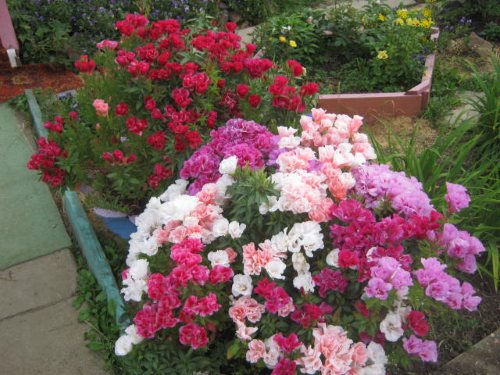

Plant in the garden
Sowing seeds for seedlings
Godetia is not very demanding on growing conditions, but is often affected by pests. Therefore, when sowing seeds, great importance is attached to disinfection.
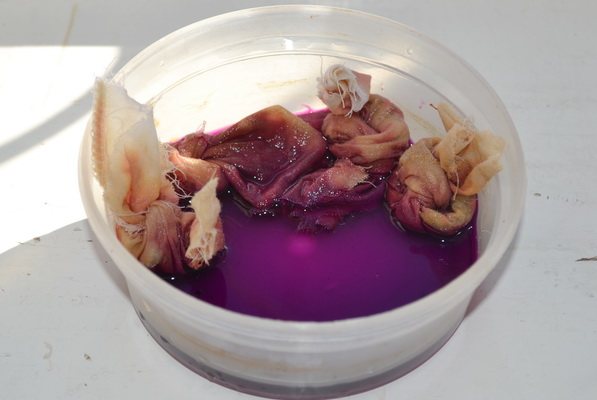

Disinfection of godetia seeds in a solution of potassium permanganate
Advice! Before sowing in the ground or for seedlings, godetia seeds must be kept for at least an hour in an intensely colored solution of potassium permanganate or disinfected in any other way.
Sowing seeds for seedlings begins at the end of March. Containers with a depth of 15 cm can be used as the first sowing containers. The pick is carried out in pots 20 cm and deeper.
- Disinfect the landing containers.
- Fill the bottom with drainage and backfill with disinfected soil.
- Moisten the soil. Wait until all the water is completely absorbed.


Moistening the soil before planting seeds - Spread the seeds sparsely over the soil.
- Sprinkle with a half-centimeter layer of peat. Do not press down.
- Cover the container with plastic foil and set in the light in a warm place (+ 20 ° С… 22 ° С).
- After germination, remove the film, water the seedlings and wait for the appearance of two real leaves.
- After that, you can dive the plants into personal pots, 2-3 pieces each, after carrying out all the disinfecting procedures of containers and soil, as when sowing seeds.
- When picking, the long central root should be shortened by a quarter.



